The need for sound insulation of air ducts used in ventilation is explained by the fact that most often they are a source of extraneous noise. If this is not done immediately after their detection, the consequences of constant noise pollution will negatively affect the health of the residents of the house. There is only one way to protect them from unwanted irritants - by high-quality sound insulation of ventilation ducts.
Sources and causes of ventilation noise
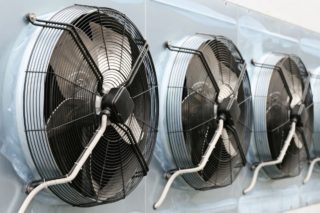
Noises of operating ventilation by the source of their formation are conventionally divided into the following types:
- air;
- vibrating;
- generating.
The first of them is formed due to the accelerated movement of air flowing through the ventilation ducts. It is possible to slightly reduce the level of this component by reducing the speed of movement of air particles. Vibration noises are generated when individual ventilation units are fixed in violation of the requirements of current standards. When evaluating them, special attention is paid to the quality of fastening of parts in the installation area of the electric fan.
Generating noise occurs when the duct system has many bends. Most often, they arise during the operation of ventilation structures of a non-standard configuration. The only way to get rid of them is to change the route of the laying.
Common design errors
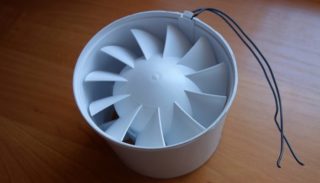
Most of the noise in the duct that interferes with normal life is formed due to mistakes made in the design and installation of the ventilation system. If nothing can be fixed in this situation, the only way out is to try to soundproof the air duct. At the same time, it should be understood that it is impossible to completely get rid of the noise. The typical mistakes of designers and installers can be avoided by adhering to the following recommendations.
Firstly, you should not use ventilation with air recirculation when it is impossible to equip a system of branch ducts. This error is typical for cases when the design is supposed to use the space between the false ceiling and the ceiling. In sub-ceiling niches and voids, air masses move along the shortest path at high speed, which provokes the occurrence of noise effects.
Secondly, it is undesirable to lay air ducts over rooms in which noise causes a lot of inconvenience to people living in them. When planning the route for laying, it is advisable to choose non-residential rooms, despite the fact that the costs in this case will increase significantly. When preparing a ventilation system project, it is recommended to pay attention to the possibility of laying air ducts in the corridor space, remote from residential premises. Sound insulation of air ducts in this case is considered as a way to correct mistakes made in the design.
Some urban and private home owners use soundproofing ventilation as an additional measure to reduce noise levels. However, they are not limited to some isolation methods, but also use common methods to reduce vibrations.
It is possible to partially neutralize the mistakes of the designers by reducing the speed of movement of the air flows (reducing the fan speed). But for such a reception you have to "pay" for a decrease in the efficiency of air renewal in residential premises.
Features and methods of noise isolation
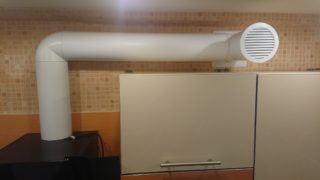
There are several ways to reduce the noise level in a domestic environment:
- competent design of the ventilation system;
- thorough study of the route of laying;
- use of air ducts without sharp bends and with a minimum of adapters.
Thanks to the above techniques, it is possible to prevent the appearance of self-generated noise and significantly reduce the likelihood of their occurrence.
An effective way to get rid of the mistakes of designers is to install a special silencer in problem areas. The soundproofing device is mounted next to the existing installation, protecting its individual units and absorbing air flows with the subsequent absorption of parasitic vibrations. There are several types of mufflers, among which plate and tubular samples stand out. The first ones are installed on rectangular air ducts, and their tubular counterparts are intended for installation on rounded branch ducts.
Sound insulation of air ducts is possible by another well-known method, in which “noisy” ducts are treated with special insulating materials. The latter are applied or attached from the inside and on the outer surfaces of the air ducts.
Also, noise insulation of ventilation can be realized using special flexible means of laying routes.
The correct selection of material for the installation of sound insulation
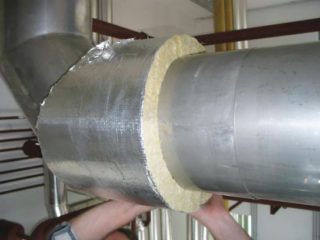
The effectiveness of sound insulation in an apartment or a country house depends on how correctly one or another protective material is selected and used. In this case, the following factors must be taken into account:
- structure that guarantees reliable absorption of interfering noise;
- simplicity and ease of installation of the material;
- the ratio of cost and quality, determining the feasibility of its use.
In problem areas of air ducts (in transitions and in the area of elbows), the insulation material used will become thinner or deformed over time. This explains the need to reapply (install) insulation, which is often used as basalt plates or mats. The plastic structure of these products guarantees good protection against unwanted deformations.
Another option for processing air ducts is the use of the technology of spraying polymer materials on the surface of mines, channels or pipes. Among them, Izolon or self-adhesive Izolontape are very popular. This method is considered an effective noise suppression option, but should be used with caution.
When trying to soundproof a duct fan, for example, applying a protective coating to areas of strong vibrations only increases their intensity. A good result is achieved if materials with a solid structure are selected from the same group as the duct itself. It is desirable that they ideally follow the contours of the laid air channel.
DIY noise isolation
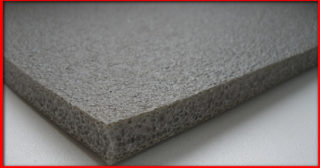
Soundproofing of the hood and the air ducts outgoing from it is possible at home without the involvement of third-party specialists. For these purposes, polymer and rubber protective compounds are suitable, which effectively attenuate low-frequency noise (they are most dangerous to human health). These materials, produced in solid and liquid form, are characterized by ease of application and the ability to take the shape of the surface to be protected.On solid boards, a special adhesive coating is provided, which allows them to be securely and firmly fixed.
The procedure for carrying out protective measures:
- The slabs of the material selected by the user (foamed polyethylene, for example) are prepared.
- The protected surfaces are cleaned of the dirt present on them.
- A layer of acrylic glue is applied if the boards are not self-adhesive.
The main stage of insulation work is the pasting with the selected material of the places to be protected. When conducting them, close attention is paid to hard-to-reach areas, which are processed with special care.








